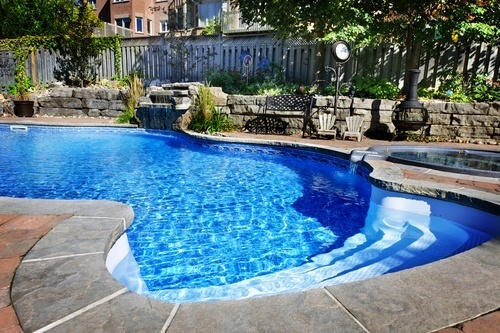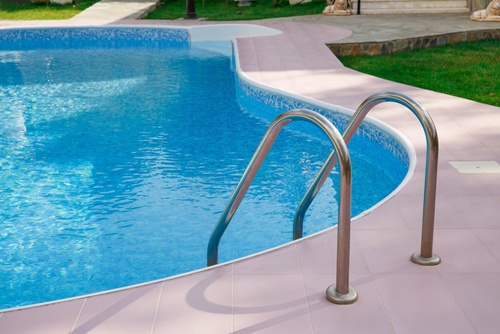Saltwater vs Chlorine Pool
Saltwater Pool
$70 - $100
(yearly salt and chemical cost)
VS
Chlorine Pool
$300 - $800
(yearly chemical cost)
Cost to build a saltwater or a chlorine pool varies greatly by region (and even by zip code).
To get free estimates from local contractors, please indicate yours.
Saltwater Pool

- Lower concentration of chlorine
- Softer on swimmer’s skin
- Doesn’t fade swimsuits
- Costs less in maintenance chemicals
- Requires less frequent maintenance
- More expensive to install
- Uses more electricity ($36 to $48, added electricity cost)
- Repairs may require a professional
- Salt water can damage pool features, plants, and soil
(yearly salt and chemical cost)
Get free advice and estimates from swimming pool builders in your city.
Chlorine Pool

- Less costly initial investment
- Uses less electricity
- Problems usually solved by homeowner
- Does not cause damage to pool features
- Higher concentration of chlorine
- Chlorine must be added to the pool
- Can cause skin to itch and dry out
- Chlorine must be stored and used carefully
- More expensive and frequent maintenance
- Needs to be “shocked” more often
(yearly chemical cost)
Get free advice and estimates from swimming pool builders in your city.
A sparkling, clear pool in the backyard can make you feel as if you have your own slice of paradise. And plunging into the cool water is a refreshing way to escape the reality of a hot summer day. In the sections below, we will explain the differences between two systems for maintaining backyard pools, a saltwater system and a traditional chlorine 1 system, so that you can decide which one is better for your home.
Chlorine and Salt Levels
It is a common misconception that saltwater systems do not have chlorine 1. In fact, these systems are currently the most popular of the chlorine systems. A saltwater pool will have lower levels of chlorine than a traditional chlorine pool because the chlorine is produced at a steady level rather than added to the pool with chlorine sticks or tablets. Salt is added to the pool instead, and a saltwater generator produces hypochlorous acid for sanitation through electrolysis, which is the breakdown of the salt by passing electricity through the saltwater solution.
Despite the name of a saltwater pool, the salt content is approximately that of human tears, about one-tenth the salinity of ocean water. Swimmers can open their eyes underwater, and their skin feels softer after a swim.
Health Issues
The lower chlorine concentration of a saltwater pool will be gentler on a swimmer’s skin. This is a particular benefit to swimmers with allergies, but anyone will enjoy smoother skin when swimming in the pool. The lower level in a saltwater pool also reduces swimsuit fading. Chlorine in a traditional pool is higher in concentration and can cause the skin to itch, burn, and become dry.
As an added health benefit, storage of salt requires no special considerations, but chlorine must be stored with regards to maintaining its effectiveness and preventing hazards to homeowners who might breathe the fumes of the chlorine products. It should be kept in a cool, dry, and well-ventilated location. Brian Bokowy, Technical Services Manager with BioLab Inc. in Decatur, Georgia, said in a Chicago Tribune article, “Safe handling and storage instructions are required to be printed on the outside of the container and should be read each time you purchase the product.”
Costs
The greatest disadvantage of a saltwater pool is the upfront cost of the saltwater generator, which costs between $400 and $1,800. The installation will be about $300 to $500. The cost of salt to set up the pool is not an expensive consideration. Pool salt costs approximately $5 per 40-pound bag, and 400 to 1,000 pounds will be needed, depending on the size of the pool. This would be an initial investment in salt of about $50 to $125, bringing the initial cost of the saltwater system to about $750 to $2,425. This start-up investment may be recouped in a few years with less expensive day-to-day chemical needs.
A saltwater pool requires less than $100 a year in salt and chemicals if it is consistently maintained. A chlorine pool, on the other hand, will cost between $300 and $800 per year in maintenance chemicals. The warmer the climate is, however, the more chlorine will be required, and the harder a saltwater pool’s generator has to work. This means the generator will use more electricity, and the cells will wear out faster than the typical lifespan of three to five years. A new cell will cost between $200 and $700. These factors may mean that the cost savings for a saltwater system will be less dramatic. At the same time, a traditional pool in a warm climate will use more chlorine as well, making the chemical costs go up. A conversation with local swimming pool professionals may help you decide if the long-range savings of a saltwater pool should be considered when making your choice.
While the chemical cost will be lower, the electricity cost of running a saltwater system will be slightly higher, approximately $36 to $48 per year more than a traditional pool pump system. A 20,000-gallon saltwater pool will use about 500 watts of electricity to power the salt generator. This is in addition to the electricity required for the pool pump and other features. Most pool professionals agree that the saltwater generator should run about four to six hours per day in the winter and about ten to twelve hours per day in the summer. These numbers will vary depending on the water temperature and how much you use the pool. The cost of this added electricity may be considered a long-range expense of running your pool.
Maintenance
Perhaps the greatest benefit of a saltwater system to homeowners is the low maintenance the pool requires. The most up-to-date systems can maintain a clean and sparkling pool for up to two weeks without intervention. By contrast, a traditional chlorine pool requires weekly maintenance with chlorine 1 tablets or sticks added regularly. Both pools will need the chlorine level checked on a regular basis to keep the chlorine level within the correct zone for having a clean, clear pool. The difference is that a saltwater pool’s chlorine is adjusted at the generator control box and by adding more salt to the water. By contrast, the chlorine system must be adjusted by the amount of chlorine physically added to the pool.
The chlorine pool will also need periodic “shocks” of more concentrated chlorine to ward off algae and maintain consistent chlorine levels. This involves dissolving chlorine in a bucket of water and adding it slowly to the pool. A saltwater pool needs this shock treatment less often, usually only after an especially heavy rain or when algae begin to bloom, making the pool turn green.
One difficulty with a saltwater pool is when a problem arises. The solution may be more complex than that of a traditional chlorine system and may require a pool professional to solve it. Homeowners can solve most chlorine pool issues using home testing kits and the right combination of chemicals.
An added maintenance necessity for the saltwater pool is checking the saltwater generator cells. They should be removed, inspected, and cleaned at least once a season.
Swimming Pool Features
One concern about saltwater systems is the effect the salt water has on the pool parts, such as the lighting, liner, and masonry work. This is especially true with a conversion of an existing chlorine system to a saltwater system because the original pool features may not have been designed to work well with salt water. For example, a concrete pool will likely need to be resurfaced sooner than if it remained a traditional chlorine pool. However, when installing a system in a new pool, the features can be chosen that will better withstand exposure to salt water. Fiberglass, as an example, is not affected by salt water and can be used as a saltwater pool surface.
Landscaping around the pool can be damaged by exposure to salt water. Due to the adverse effects on soil nutrients and plants, some communities ban these systems. Check local ordinances before installing a saltwater system. Traditional chlorine pools, however, do not have these issues with landscaping and soil.
Remodeling Terms Cheat Sheet
Definitions in laymen's terms, cost considerations, pictures and things you need to know.See full cheat sheet.
How much does it cost to build a saltwater or a chlorine pool in my city?
Cost to build a saltwater or a chlorine pool varies greatly by region (and even by zip code).
To get free estimates from local contractors, please indicate yours.